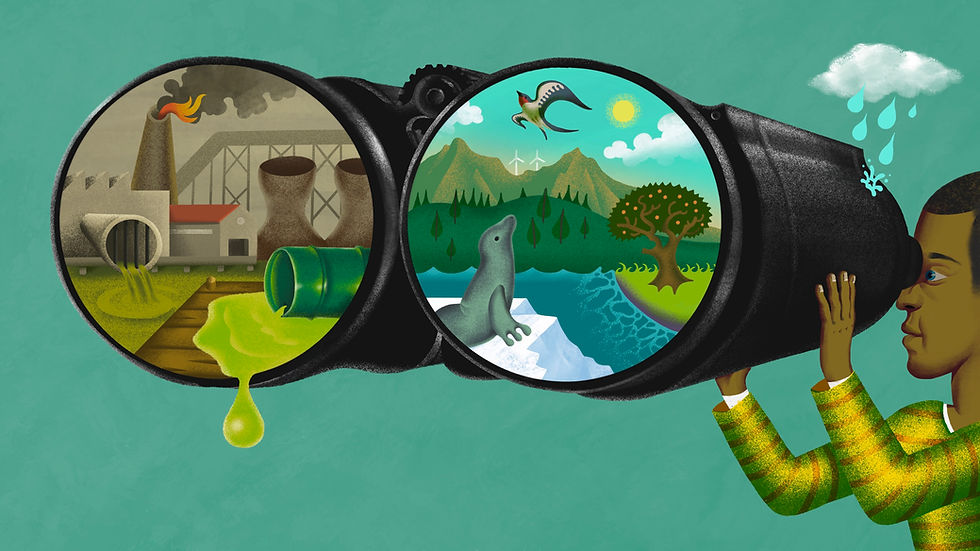Algae: Evolution, Science & Environment
- Sylvia Rose

- Feb 16
- 4 min read
Algae are a diverse range of species, from microscopic phytoplankton to massive kelp forests. Their variety comes from lack of a common ancestor. They share the ability to create energy from sunlight.

Algae are polyphyletic, descended from various species over time. They can be prokaryotes like cyanobacteria, single cells without a true nucleus, to complex collections of eukaryotic cells.
Often called blue-green algae, cyanobacteria are bacteria with the ability for photosynthesis. Their production of oxygen is a large factor in the Great Oxidation Even 2400-2100 mya.
Nonflowering water-loving plants, algae are a large group including the seaweeds and single-celled forms. There are between 30,000 and over a million species.

Algae have chlorophyll but lack true stems, roots, leaves, and vascular tissue. Like plants, algae convert light into energy through photosynthesis, using CO2 and water to produce sugars and oxygen.
Algae fall in two main categories, microalgae and macroalgae. Microalgae are microscopic, often floating freely in water, while macroalgae (seaweed) are larger, growing in many marine environments.
At the microscopic level, algae display a wide array of forms and functions. Single-celled diatoms, with beautiful silica shells, are responsible for a major part of global photosynthesis.

Dinoflagellates are another group of single-celled algae. The name comes from their two flagella which give them motility. They're found in fresh and sea water, with the majority liking saline.
About 2300 known species of dinoflagellate exist. The dinoflagellate Erythropsidinium has the smallest known eye. Some species are bioluminescent, glowing on beaches or flashing in the water.
They're known for algal blooms. Dinoflagellates like Karenia brevis are notorious for toxic red tides, which occur when weather and nutrient conditions are right.

Blooms are about a million cells per milliliter. They produce brevetoxins and saxitoxin, the cause of paralytic shellfish poisoning.
Algae provide food for organisms like fish and shellfish. Kelp forests, composed of large brown algae, can support more than 800 different species of marine life.
Algae are promoted for nutritional benefits. Species like spirulina and chlorella contain valuable proteins, vitamins, and minerals.

These microalgae are common ingredients in dietary supplements and health food. A tablespoon of spirulina contains bout 4 grams of protein.
Some seaweed species have emulsifying properties.
Red dye or pigment has been extracted from red algae. Brown seaweed like kelp is a source of essential iodine. Algae farming is big business today and helps produce oxygen through algal consumption of CO2.
Algae help regulate atmospheric carbon dioxide. In photosynthesis, they sequester significant amounts of carbon. Algae can absorb up to 1.8 billion tons of carbon dioxide annually.

Algae are fundamental to the health of aquatic environments and, by extension, the entire planet. They create 50-85% of Earth's oxygen. Algae form the base of the food web in aquatic ecosystems.
Algae is of scientific interest for:
Biofuel production: Algae can be cultivated for oils, which in a perfect world can be converted into biodiesel and other biofuels, offering a renewable alternative to fossil fuels.
Carbon capture: Algae can be used to capture carbon dioxide from industrial emissions, the largest source of pollutants.

Wastewater treatment: Algae can absorb nitrogen and phosphorus to remove bloom-feeding nutrients from wastewater. Countless microbes are investigated for bioremediation, arousing questions as to the facts behind this chronic need. An interesting species is Cupriavidus metallidurans, which eats metal and produces gold.
Algae are also vulnerable to pollution. A major problem is nutrient runoff from agricultural fertilizers, especially containing phosphates, creating harmful algal blooms like green or red tides.

These reduce oxygen levels and release poisons such as brevetoxins. Blooms deplete oxygen levels in water, creating "dead zones" especially along shorelines.
Microalgae are natural water filters. They absorb organic substances from wastewater, biodegrade pollutants and assimilate CO2, helping improve water quality.

Food and feed: Algae are a rich source of protein, vitamins, and minerals, potential ingredients for human and animal feed. For thousands of years, seaweed farming has been part of East Asian culinary traditions.
Fossils of isolated spores show land plants to exist as early as 475 million years ago during the Late Cambrian/Early Ordovician period. According to the theory, plants evolve from sessile shallow freshwater charophyte algae.
The algae is stranded on land when water levels drop during dry seasons and must adapt or die. They evolve filamentous thalli and holdfasts resembling plant stems and roots.

Symbiosis
Some algae species create symbiotic relationships with other organisms. In these partnerships, the algae provide nutrition to the host, which in turn offers protection to the algal cells. The host organism meets some or all its energy needs through the algae.
Paramecium bursaria is a ciliate species of marine and brackish waters. It has a mutualistic endosymbiotic relationship with the green algae Zoochlorella.
The algae live inside the transparent ciliate, producing oxygen and nutrients. In exchange they get protection and a scenic ride through the competitive microworld.

Non-Fiction Books:
Fiction Books:
READ: Lora Ley Adventures - Germanic Mythology Fiction Series
READ: Reiker For Hire - Victorian Detective Murder Mysteries


